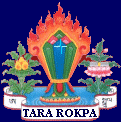 |
Outline of the Tara Rokpa ProcessBack to
Beginnings
The Tara Rokpa process is a long-term project of personal growth and development running over several years. Although the work is basically individual, a supportive group context is recommended. The individual steps or levels can be followed at one's own pace, but through the group connection there is a certain time frame given. Usually the first phase takes two to three years, the following phases about a year each. The Tara Rokpa process is alive, grows and develops out of the experiences of those who are using it. 1. Back to Beginnings This is an investigation of one's life as a whole. It helps us to see how we are, what has happened to us and what we are realistically working with on the subsequent levels. We develop a solid foundation/basis in our own lived experience - good or bad, difficult or joyful. Parts of this process are, amongst others, a detailed writing of our own memories of this life in a particular way, relaxation and visualization exercises, uncovering our creative potential with paints and other art materials, and simple, intuitive massage. A certain minimum time commitment is required in order to get real benefit. Three hours a week are the minimum to keep a sense of continuity and achieve a satisfactory depth in the exercises and the remembering process. The amount of overall time spent on this will depend on how deep one wants to go and how much previous personal work one has done in this area. Working with the Elements is a stage within Back to Beginnings. It is based on the view that we are not separate from our universe and are made from the same basic principles. In this work we explore each of the five Elements (earth, water, fire air, space) as they occur in nature and how we relate to them bodily and in our feelings/emotions. We enter into a relationship with the natural world in us and around us, through direct experience and inner exploration of the inner and outer aspects of relationships and realities of the elements. The following year puts an emphasis on our present life and relationships and the necessity to develop a strong base of compassion for ourselves. Given that many people in the West do not have such a base there is time and space given to return again and again to building self-esteem, self-worth and a feeling of personal dignity. At the same time meditational exercises help to work on our relationships to others and on developing a broader sense of relatedness. 2. Taming the Tiger The emphasis shifts from the personal life story to working with the mind and emotions using a series of therapeutical exercises given by Akong Rinpoche and since then published in his book "Taming the Tiger" (Rider, London, 1994). They are practiced in sequence, individually as well as in the group context. The group continues to be important to help integrate creativity and relaxation through painting and massage and the mutual support with the exercises. The emphasis is on a compassionate understanding of ourselves and others, while at the same time we learn to understand our own mind on deeper and deeper levels. In the last years of the Tara Rokpa process the emphasis is more on active compassion (compassion directed outward). Tara Rokpa takes a holistic and integrative approach to human suffering. The focus is not on transcendence but on the truth of our lived experience. Whatever our experience may be it needs to be fully acknowledged for us to move on and mature. This maturing process is born of an inner richness which is experienced as we come to understand and accept various hidden and lesser known aspects of ourselves more openly. Becoming less embarrassed to be ourselves renders us more free to engage in all aspects of our world, and to be of use and help to those around us. 3. Six Lights and Six Realms In this year we work with the Six Realms of Buddhist psychology (god, demigod, human, animal, hungry ghost and hell realm) and their psychological correlates. These exercises help us to better recognize our ingrained patterns of experiencing and acting and to face them, with the goal of further inner maturation. Here we work more on the level of the underlying learned ways of being in and of the world - what could be called our personality structure. 4. Compassion In this part of the process we face suffering, our own and that of others, and thereby develop deeper compassion with ourselves and others. |
|
|
|
|